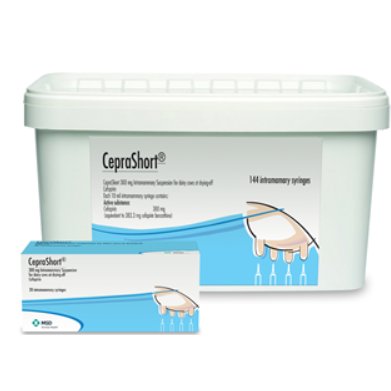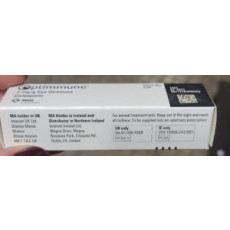CepraShort 300mg Dry Cow 144s, POM-V
![]() Available
Available
Product Description
Target species
Cattle
Indications for use
For the treatment of subclinical mastitis at drying-off caused by Staphylococcus aureus, coagulase-negative staphylococci, Streptococcus agalactiae, Streptococcus dysgalactiae and Streptococcus uberis susceptible to cefapirin.
Contraindications
Do not administer to animals which are known to be hypersensitive to cephalosporins, other beta-lactam antibiotics or to any of the excipients.
Do not use in animals suffering from severe renal disease.
In animals suffering from renal impairment use only following a benefit/risk assessment performed by the responsible veterinarian.
Do not use in cows with clinical mastitis.
Please refer also to “Use during pregnancy or lactation”.
Special warnings for each target species
None
Special precautions for use
Use of the product should be based on susceptibility testing of the bacteria isolated from the animal. If this is not possible, therapy should be based on local (regional, farm level) epidemiological information about susceptibility of the target bacteria. Use of the product deviating from the instructions given in the SPC may increase the prevalence of bacteria resistant to cefapirin and may decrease the effectiveness of treatment. Official, national and regional antimicrobial policies should be taken into account when the product is used.
The efficacy of the product is only established against the pathogens mentioned in Section “Indications for use”. Consequently, serious acute mastitis (potentially fatal) due to other pathogen species, particularly Pseudomonas aeruginosa, can occur after drying off. Good hygiene practices should be thoroughly respected in order to reduce this risk.
Do not use the cleaning towel if lesions are present on the teat.
Operator warnings
Penicillins and cephalosporins may cause hypersensitivity (allergy) following injection, inhalation, ingestion or skin contact. Hypersensitivity to penicillin may lead to cross sensitivity to cephalosporins and vice versa. Allergic reactions to these substances may occasionally be serious.
People with known hypersensitivity to penicillins or cephalosporins should avoid contact with the veterinary medicinal product.
If you develop symptoms following exposure, such as a skin rash, you should seek medical advice and show the package leaflet or the label to the physician. Swelling of the face, lips or eyes or difficulty breathing are more serious symptoms and require urgent medical attention.
Wash hands after using the cleaning towels. People with known hypersensitivity to isopropyl alcohol should avoid direct contact with the cleaning towels. Avoid eye contact since Isopropyl alcohol may cause eye irritation.
Adverse reactions
Allergic reactions have been observed very rarely.
The frequency of adverse reactions is defined using the following convention:
- very common (more than 1 in 10 animals treated displaying adverse reaction(s))
- common (more than 1 but less than 10 animals in 100 animals treated)
- uncommon (more than 1 but less than 10 animals in 1,000 animals treated)
- rare (more than 1 but less than 10 animals in 10,000 animals treated)
- very rare (less than 1 animal in 10,000 animals treated, including isolated reports).
Use during pregnancy or lactation
Do not use during lactation.
Interactions
Simultaneous parenteral administration of nephrotoxic substances (e.g. aminoglycoside and polypeptide antibiotics) may prolong excretion of cefapirin.
Concomitant use of cephalosporins and nephrotoxic drugs may increase renal toxicity.
Cephalosporins should not be administered concurrently with bacteriostatic antimicrobials.
Amounts to be administered and administration route
For single intramammary use only.
The contents of one syringe should be infused into the teat canal of each quarter immediately after the last milking of the lactation. Before infusion, the teat should be thoroughly cleaned and disinfected with the cleaning towel provided.
Remove the cap fully by holding the barrel of the syringe firmly in one hand and push up the cap with the thumb along the length of the cap until the cap clicks off. Take care not to contaminate the nozzle. Do not bend the nozzle.
Insert the nozzle into the teat canal and infuse the contents of one syringe.
Holding the end of the teat with one hand, gently massage upwards with the other hand to aid dispersion of the antibiotic into the quarter.
The intramammary syringe must only be used once.
After treatment, it is recommended to dip the teats in an appropriate disinfectant solution.
Overdose
None known.
Withdrawal periods
Milk: 24 hours after calving if the interval between treatment and calving is 32 days or longer.
33 days after treatment if the interval between treatment and calving is less than 32 days.
Meat and offal: 14 days
The udder of treated cows must not be used for human consumption during the dry period and the following lactation period.
Loyalty Scheme
Earn up to 372 loyalty points with this product.
















Share
CepraShort 300mg Dry Cow 144s, POM-V
Facebook Twitter Email Pinterest Telegram